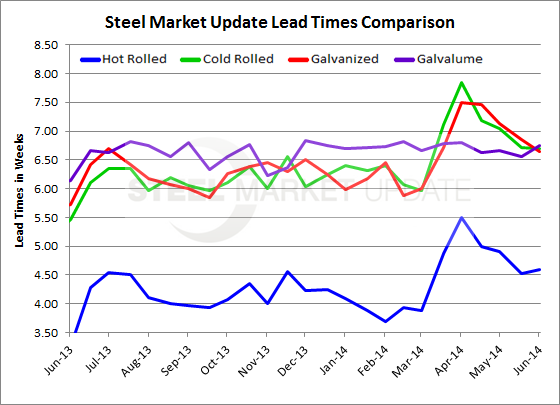SMU Data and Models

Mill Lead Times Stable to Extended
Written by John Packard
June 22, 2014
Flat rolled steel mill lead times continue to be extended compared to one year ago according to the results of the SMU steel survey completed late last week. Hot rolled lead times average 4.59 weeks, which is about the same as what was reported at the beginning of the month of June. One year ago HRC lead times were measured at 3.26 weeks. Hot rolled lead times peaked at 5.49 weeks in mid-April of this year.
Cold rolled lead times average 6.70 weeks, again about the same as earlier this month and well above the 5.46 weeks reported one year ago. The 6.70 weeks is about one week shorter than what we were seeing out of our survey during the months of April and May.
Galvanized lead times average 6.64 weeks, down slightly from the 6.86 weeks measured at the beginning of the month. Last year at this same point in the year, GI averaged 5.46 weeks. The lengthiest lead times we have seen this year was 7.84 weeks which was recorded during the middle of April.
Galvalume lead times extended slightly this past week and now average 6.75 weeks. This is very close to the mid-April 2014 peak of 6.80 weeks. Last year AZ lead times were reported as being 6.14 weeks.
With lead times stabilizing at historically (over the past few years) longer than normal levels has helped moderate the slide we had seen in pricing over the past few weeks (see lead time graph below).

John Packard
Read more from John PackardLatest in SMU Data and Models

SMU Scrap Survey: Sentiment Indices rise
Both current and future scrap sentiment jumped this month, though survey participants reported responses before key trade news was announced.

SMU Survey: Sentiment splits, buyers have better view of future than the present
SMU’s Steel Buyers’ Sentiment Indices moved in opposite directions this week. After rebounding from a near five-year low in late June, Current Sentiment slipped again. At the same time, Future Sentiment climbed to a four-month high. Both indices continue to show optimism among buyers about their company’s chances for success, but suggest there is less confidence in that optimism than earlier in the year.

SMU scrap market survey results now available
SMU’s ferrous scrap market survey results are now available on our website to all premium members. After logging in at steelmarketupdate.com, visit the pricing and analysis tab and look under the “survey results” section for “ferrous scrap survey” results. Past scrap survey results are also available under that selection. If you need help accessing the survey results […]

SMU flat-rolled market survey results now available
SMU’s latest steel buyers market survey results are now available on our website to all premium members. After logging in at steelmarketupdate.com, visit the pricing and analysis tab and look under the “survey results” section for “latest survey results.” Past survey results are also available under that selection. If you need help accessing the survey results, or if […]

SMU Survey: Sheet lead times stabilize, plate contracts
Mill lead times for sheet products were steady to slightly longer this week compared to our late June market check, while plate lead times contracted, according to steel buyers responding to this week’s market survey.

